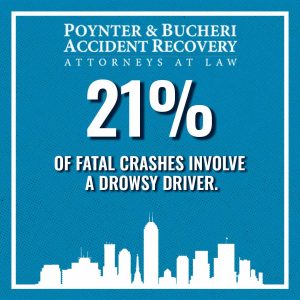
Drowsy Driving: How Sleep Deprivation Affects Drivers

The peril posed by drowsy driving extends beyond the driver to encompass all road users. The hazards tied to sleepiness while driving not only lead to injuries but, tragically, can result in fatalities. A preventable calamity can arise from driver fatigue or insufficient sleep. Regrettably, occurrences of drowsy driving accidents are more frequent than commonly assumed.

An Unveiling of Drowsy Driving’s Prevalence
Statistics from the Center for Disease Control (CDC) indicate that 1 in 25 adults confess to dozing off while driving within the past month. Furthermore, the AAA Foundation for Traffic Safety estimations revealed that 21% of fatal crashes involve a drowsy driver. If you have lost a loved one or suffered injuries from an accident caused by a drowsy driver, you may be entitled to compensation for your losses.
Indicators of Sleepiness While Driving
How does sleep deprivation affect drivers? Recognizing when you are tired while driving and when to pull over for rest is vital, and certain signs to heed include:
- Struggling to concentrate, frequent blinking, or heavy eyelids
- Mind wandering or drifting thoughts
- Difficulty recalling the last few miles driven
- Missing exits or traffic signs
- Frequent yawning or eye rubbing
- Struggling to keep the head up
- Veering out of the lane or hitting rumble strips
- Feeling restless or irritable
If you start to notice any of these signs, you could be a sleepy driver. It is imperative to locate a safe and unobstructed spot to rest. Remaining off the road until fully alert is essential for your safety and the safety of those around you.
Managing Sleepiness While Driving
Detecting a sleepy driver can be challenging, often realized too late. Being familiar with the signs empowers drivers to pull over safely when needed or encourage friends and family to do so. Suggestions for managing driver fatigue include:
- Changing drivers if a rested licensed driver is available
- Consuming caffeinated beverages like coffee or energy drinks
- Seeking lodging for proper rest
- Avoiding cruise control to maintain full engagement
- Keeping windows open
- Listening to invigorating yet non-distracting music
While these measures promote awareness, they are not substitutes for drowsy driving prevention. Coffee may offer a temporary reprieve but it does not cure driver fatigue. The optimal course is to refrain from driving until fully rested and capable of driving safely.
Preventing Sleepiness While Driving Incidents
While individuals can adopt safety precautions, they cannot control the actions of others. Numerous drowsy driving accidents stem from fatigued drivers sharing the road. Regrettably, many of these mishaps are avoidable.
Consider these strategies to prevent drowsy driving accidents:
- Opt for daytime driving
- Be vigilant for road dangers, such as lane intrusions
- Remain alert at all times
In cases where a sleepy driver’s negligence has caused injury, pursuing a car accident claim or even legal action might be warranted. Compensation is available for those harmed by tired driving.
Common Factors Contributing to Drowsy Driving
Several factors elevate the risk of drowsy driving incidents, with specific conditions standing out:
Age: Teenagers and seniors are often more susceptible to drowsy driving due to their distinctive characteristics and circumstances. Adolescents, influenced by peer dynamics and disrupted sleep patterns, are prone to recklessness. Conversely, elderly drivers might grapple with age-related health issues that cause unpredictable sleeping patterns.
Substance Use: Ingesting alcohol, drugs, or medications can exacerbate driver fatigue, impairing judgment and reaction times.
Night Shift Work: Night shift workers returning home after prolonged shifts often wrestle with disrupted sleep patterns, contributing to drowsy driving dangers.
Sleep Disorders: Conditions like sleep apnea and narcolepsy heighten the risk of falling asleep while driving. Those with sleep disorders should exercise caution before operating a vehicle.
Time of Day: The hours between midnight and 6:00 am, along with late afternoon, witness a spike in drowsy driving accidents as fatigue peaks.
Holidays: Festive occasions, often accompanied by indulgent meals and celebrations, can lead to drowsy driving. Balancing merriment with rest is crucial during such times.
Responding to a Drowsy Driving Incident
Following a drowsy driving accident, prioritize safety and take the following steps:
- Move to a safe location if possible.
- Check for injuries and seek medical attention if necessary.
- Call 911 to report the accident.
- Document the scene with photos and videos.
- Gather insurance information.
- Collect witness information.
- Contact legal representation for guidance.
Understanding Indiana Car Accident Laws
Indiana’s statute of limitations grants a two-year window to file a claim after an accident. Initiating the process early allows for comprehensive evidence collection and a stronger case. Consulting an attorney promptly following a drowsy driving accident is the best course of action for you to take.
Contact Poynter and Bucheri Accident Recovery Attorneys at Law
If you’ve been involved in a drowsy driving accident, the driver’s negligence is evident. Operating a vehicle while fatigued is irresponsible and can result in devastating consequences. You may be eligible to seek compensation through a car accident claim or a lawsuit. Consulting an experienced car accident attorney is crucial for navigating the legal process and ensuring fair compensation.
Contact us at Poynter and Bucheri if you have a question about or have been in a drowsy driving accident. Give us a call at 1-800-265-9881 to schedule your free consultation today.
